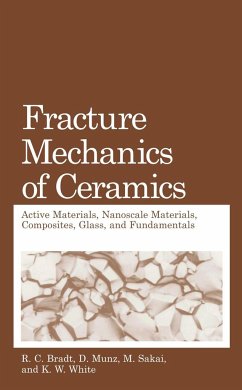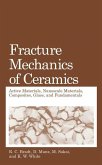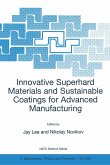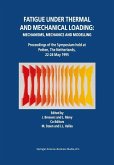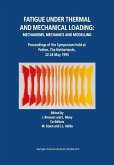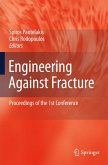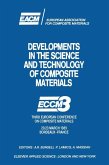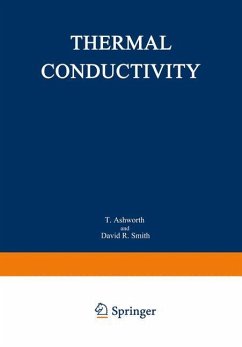R.C. Bradt / D. Munz / M. Sakai / K.W. White (eds.)Active Materials, Nanoscale Materials, Composites, Glass, and Fundamentals
Fracture Mechanics of Ceramics
Active Materials, Nanoscale Materials, Composites, Glass, and Fundamentals
Herausgegeben:Bradt, R.C.; Munz, D.; Sakai, M.; White, Ken W.
R.C. Bradt / D. Munz / M. Sakai / K.W. White (eds.)Active Materials, Nanoscale Materials, Composites, Glass, and Fundamentals
Fracture Mechanics of Ceramics
Active Materials, Nanoscale Materials, Composites, Glass, and Fundamentals
Herausgegeben:Bradt, R.C.; Munz, D.; Sakai, M.; White, Ken W.
- Gebundenes Buch
- Merkliste
- Auf die Merkliste
- Bewerten Bewerten
- Teilen
- Produkt teilen
- Produkterinnerung
- Produkterinnerung
The 8th International Symposium on fracture mechanics of ceramics was held in on the campus of the University of Houston, Houston, TX, USA, on February 25-28, 2003. With the natural maturing of the fields of structural ceramics, this symposium focused on nano-scale materials, composites, thin films and coatings as well as glass. The symposium also addressed new issues on fundamentals of fracture mechanics and contact mechanics, and a session on reliability and standardization.
Andere Kunden interessierten sich auch für
![Fracture Mechanics of Ceramics Fracture Mechanics of Ceramics]() Fracture Mechanics of Ceramics224,99 €
Fracture Mechanics of Ceramics224,99 €![Innovative Superhard Materials and Sustainable Coatings for Advanced Manufacturing Innovative Superhard Materials and Sustainable Coatings for Advanced Manufacturing]() Jay Lee / Nikolay Novikov (eds.)Innovative Superhard Materials and Sustainable Coatings for Advanced Manufacturing161,99 €
Jay Lee / Nikolay Novikov (eds.)Innovative Superhard Materials and Sustainable Coatings for Advanced Manufacturing161,99 €![Fatigue under Thermal and Mechanical Loading: Mechanisms, Mechanics and Modelling Fatigue under Thermal and Mechanical Loading: Mechanisms, Mechanics and Modelling]() Fatigue under Thermal and Mechanical Loading: Mechanisms, Mechanics and Modelling161,99 €
Fatigue under Thermal and Mechanical Loading: Mechanisms, Mechanics and Modelling161,99 €![Fatigue under Thermal and Mechanical Loading: Mechanisms, Mechanics and Modelling Fatigue under Thermal and Mechanical Loading: Mechanisms, Mechanics and Modelling]() J. Bressers / L. R‚my (Hgg.)Fatigue under Thermal and Mechanical Loading: Mechanisms, Mechanics and Modelling161,99 €
J. Bressers / L. R‚my (Hgg.)Fatigue under Thermal and Mechanical Loading: Mechanisms, Mechanics and Modelling161,99 €![Engineering Against Fracture Engineering Against Fracture]() Spiros Pantelakis / Chris Rodopoulos (ed.)Engineering Against Fracture112,99 €
Spiros Pantelakis / Chris Rodopoulos (ed.)Engineering Against Fracture112,99 €![Developments in the Science and Technology of Composite Materials Developments in the Science and Technology of Composite Materials]() Developments in the Science and Technology of Composite Materials79,99 €
Developments in the Science and Technology of Composite Materials79,99 €![Thermal Conductivity 18 Thermal Conductivity 18]() T. AshworthThermal Conductivity 1841,99 €
T. AshworthThermal Conductivity 1841,99 €-
-
-
The 8th International Symposium on fracture mechanics of ceramics was held in on the campus of the University of Houston, Houston, TX, USA, on February 25-28, 2003. With the natural maturing of the fields of structural ceramics, this symposium focused on nano-scale materials, composites, thin films and coatings as well as glass. The symposium also addressed new issues on fundamentals of fracture mechanics and contact mechanics, and a session on reliability and standardization.
Produktdetails
- Produktdetails
- Fracture Mechanics of Ceramics 14
- Verlag: Springer / Springer US / Springer, Berlin
- Artikelnr. des Verlages: 978-0-387-24134-0
- 2005 edition
- Seitenzahl: 636
- Erscheinungstermin: 29. Juli 2005
- Englisch
- Abmessung: 264mm x 177mm x 38mm
- Gewicht: 1388g
- ISBN-13: 9780387241340
- ISBN-10: 0387241345
- Artikelnr.: 21745320
- Herstellerkennzeichnung
- Libri GmbH
- Europaallee 1
- 36244 Bad Hersfeld
- gpsr@libri.de
- Fracture Mechanics of Ceramics 14
- Verlag: Springer / Springer US / Springer, Berlin
- Artikelnr. des Verlages: 978-0-387-24134-0
- 2005 edition
- Seitenzahl: 636
- Erscheinungstermin: 29. Juli 2005
- Englisch
- Abmessung: 264mm x 177mm x 38mm
- Gewicht: 1388g
- ISBN-13: 9780387241340
- ISBN-10: 0387241345
- Artikelnr.: 21745320
- Herstellerkennzeichnung
- Libri GmbH
- Europaallee 1
- 36244 Bad Hersfeld
- gpsr@libri.de
Contact Mechanics.- Atomic Force Microscopy at Ultrasonic Frequencies.- Indentation Size Effect on the Hardness of Zirconia Polycrystals.- Indentation Fracture, Acoustic Emission and Modelling of the Mechanical Properties of Thin Ceramic Coatings.- Nanoindentation, Nanoscratch and Nanoimpact Testing of Silicon-Based Materials with Nanostructured Surfaces.- Microstructural Control of Indentation Crack Extension under Externally Applied Stress.- Instrumented Hardness Test on Alumina Ceramics and Single Crystal with Spherical Indenter.- Glass.- Controlling the Fragmentation Behavior of Stressed Glass.- Elasto-Plastic Behavior of Glassy Carbon and Silica Glass by Nano-Indentation with Spherical Tipped Indenter.- Scratch Test for Evaluation of Surface Damage in Glass.- Shear Driven Damage and Internal Friction in Indentation Loading of a Glass-Ceramic.- Indentation and Scratching of Glass: Load, Composition and Temperature Effects.- Effects of Tin on the Physical Properties and Crack Growth in Soda-Lime-Silica Float Glass.- Indentation Size Effect for Glasses: Yes, There is a Fracture Contribution.- Fracture of Nano-Scale Materials.- Slow Crack Propagation in Ceramics at the Nano- and Micro-Scale: Effect of the Microstructure.- Toughening and Strengthening Mechanisms in Nanocomposites Based on Dislocation Activity.- Composites.- Creep Behavior and Mechanism for CMCs with Continuous Ceramic Fibers.- Strain Accumulation and Damage Evolution During Creep of SiCf/SiC Composites.- Modelling Multilayer Damage in Cross-ply Ceramic Matrix Composites.- Quantification of Toughness Increase Due to Metal Particles in Glass Matrix Composites.- Fracture Resistance of Hybrid Glass Matrix Composite and Its Degradation Due to Thermal Ageing and Thermal Shock.- Creep Investigation of SiCf-SiBC Composites.- Fracture Toughness of BaTiO3-MgO Composites Sintered by Spark Plasma Sintering.- Fracture Toughness of BaTiO3 and BaTiO3-Al2O3 Composite under Electric Field.- Room Temperature Post-Fracture Tensile (PFT) Study of Two Fiber-Reinforced Ceramic Matrix Composites with a "Strong" Fiber/Matrix Interface.- A FE Model of Carbon/Carbon Composite Fracture.- Fracture Fundamentals.- Tailoring the Composition of Self-Reinforced Silicon Nitride Ceramics to Enhance Mechanical Behavior.- Nonlinear Fracture of a Polycrystalline Graphite - Size-Effect Law and Irwin's Similarity.- Fragmentation of Ceramics in Rapid Expansion Mode.- Experimental Approach to Microfracture Process of Ceramics under Thermal Shock.- Finite Element Analysis of Crack-Path Selection in a Brick and Mortar Structure.- Investigation of Crack Growth Process in Dense Hydroxyapatite Using the Double Torsion Method.- Crack Propagation Behavior of Alumina with Different Grain Sizes under Static and Cyclic Fatigue.- Effects of Pore/Grain-Size Interaction and Porosity on the Fracture of Electroceramics.- Fracture of Coatings.- Fracture Behaviour of Plasma Sprayed Thermal Barrier Coatings.- Particle Impact Damage and Point Load-Induced Fracture Behavior in Zirconia Plasma Spray Coating Film.- Model I, Mode II, and Mixed-Mode Fracture of Plasma-Sprayed Thermal Barrier Coatings at Ambient and Elevated Temperatures.- Ferroelectric Materials.- Modeling of Fracture in Ferroelastic Ceramics.- Strength and Reliability of Lead Zirconate Titanate Ceramics.- Reliability Prediction, Standardization and Design.- Standard Reference Material 2100: Fracture Toughness of Ceramics.- Measuring the Real Fracture Toughness of Ceramics: ASTM C 1421.- Predicting the Reliability of Brittle Material Structures Subjected toTransient Proof Test and Service Loading.- Estimation and Simulation of Slow Crack Growth Parameters from Constant Stress Rate Data.- On Integrity of Flexible Displays.- Fracture of Conductive Cracks in Poled and Depoled PZT-4 Ceramics.- Increasing Resistance to Low Temperature Ageing Degradation of Y-TZP by Surface Modification.
Contact Mechanics.- Atomic Force Microscopy at Ultrasonic Frequencies.- Indentation Size Effect on the Hardness of Zirconia Polycrystals.- Indentation Fracture, Acoustic Emission and Modelling of the Mechanical Properties of Thin Ceramic Coatings.- Nanoindentation, Nanoscratch and Nanoimpact Testing of Silicon-Based Materials with Nanostructured Surfaces.- Microstructural Control of Indentation Crack Extension under Externally Applied Stress.- Instrumented Hardness Test on Alumina Ceramics and Single Crystal with Spherical Indenter.- Glass.- Controlling the Fragmentation Behavior of Stressed Glass.- Elasto-Plastic Behavior of Glassy Carbon and Silica Glass by Nano-Indentation with Spherical Tipped Indenter.- Scratch Test for Evaluation of Surface Damage in Glass.- Shear Driven Damage and Internal Friction in Indentation Loading of a Glass-Ceramic.- Indentation and Scratching of Glass: Load, Composition and Temperature Effects.- Effects of Tin on the Physical Properties and Crack Growth in Soda-Lime-Silica Float Glass.- Indentation Size Effect for Glasses: Yes, There is a Fracture Contribution.- Fracture of Nano-Scale Materials.- Slow Crack Propagation in Ceramics at the Nano- and Micro-Scale: Effect of the Microstructure.- Toughening and Strengthening Mechanisms in Nanocomposites Based on Dislocation Activity.- Composites.- Creep Behavior and Mechanism for CMCs with Continuous Ceramic Fibers.- Strain Accumulation and Damage Evolution During Creep of SiCf/SiC Composites.- Modelling Multilayer Damage in Cross-ply Ceramic Matrix Composites.- Quantification of Toughness Increase Due to Metal Particles in Glass Matrix Composites.- Fracture Resistance of Hybrid Glass Matrix Composite and Its Degradation Due to Thermal Ageing and Thermal Shock.- Creep Investigation of SiCf-SiBC Composites.- Fracture Toughness of BaTiO3-MgO Composites Sintered by Spark Plasma Sintering.- Fracture Toughness of BaTiO3 and BaTiO3-Al2O3 Composite under Electric Field.- Room Temperature Post-Fracture Tensile (PFT) Study of Two Fiber-Reinforced Ceramic Matrix Composites with a "Strong" Fiber/Matrix Interface.- A FE Model of Carbon/Carbon Composite Fracture.- Fracture Fundamentals.- Tailoring the Composition of Self-Reinforced Silicon Nitride Ceramics to Enhance Mechanical Behavior.- Nonlinear Fracture of a Polycrystalline Graphite - Size-Effect Law and Irwin's Similarity.- Fragmentation of Ceramics in Rapid Expansion Mode.- Experimental Approach to Microfracture Process of Ceramics under Thermal Shock.- Finite Element Analysis of Crack-Path Selection in a Brick and Mortar Structure.- Investigation of Crack Growth Process in Dense Hydroxyapatite Using the Double Torsion Method.- Crack Propagation Behavior of Alumina with Different Grain Sizes under Static and Cyclic Fatigue.- Effects of Pore/Grain-Size Interaction and Porosity on the Fracture of Electroceramics.- Fracture of Coatings.- Fracture Behaviour of Plasma Sprayed Thermal Barrier Coatings.- Particle Impact Damage and Point Load-Induced Fracture Behavior in Zirconia Plasma Spray Coating Film.- Model I, Mode II, and Mixed-Mode Fracture of Plasma-Sprayed Thermal Barrier Coatings at Ambient and Elevated Temperatures.- Ferroelectric Materials.- Modeling of Fracture in Ferroelastic Ceramics.- Strength and Reliability of Lead Zirconate Titanate Ceramics.- Reliability Prediction, Standardization and Design.- Standard Reference Material 2100: Fracture Toughness of Ceramics.- Measuring the Real Fracture Toughness of Ceramics: ASTM C 1421.- Predicting the Reliability of Brittle Material Structures Subjected toTransient Proof Test and Service Loading.- Estimation and Simulation of Slow Crack Growth Parameters from Constant Stress Rate Data.- On Integrity of Flexible Displays.- Fracture of Conductive Cracks in Poled and Depoled PZT-4 Ceramics.- Increasing Resistance to Low Temperature Ageing Degradation of Y-TZP by Surface Modification.

